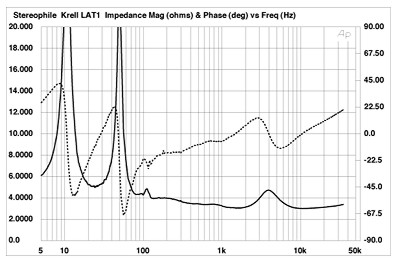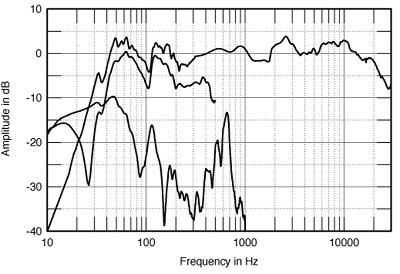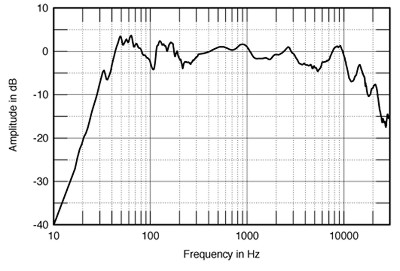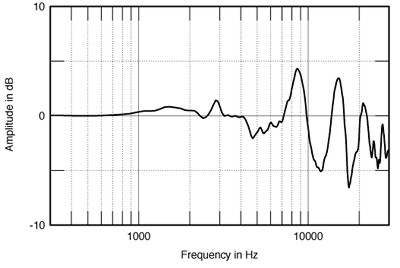| Columns Retired Columns & Blogs |
Krell LAT-1 loudspeaker Measurements
Sidebar 4: Measurements
As befit the Krell LAT-1's heroic construction, I could find no significant vibrational modes in its cabinet. The Krell is a very sensitive loudspeaker—my estimate of its B-weighted sensitivity came in at 92dB(B)/2.83V/m. However, as shown by its impedance plot (fig.1), it is a 4 ohm design, drawing 2W rather than 1W from the partnering amplifier to reach this measured sensitivity. The minimum impedance is 3 ohms at 1.5kHz, and the phase angle in the midrange and treble is generally low. However, the combination of 5 ohms magnitude and 45 degrees capacitive phase angle at 60Hz means that the LAT-1 requires a beefy amplifier (such as one of Krell's own).

Fig.1 Krell LAT-1, electrical impedance (solid) and phase (dashed). (2 ohms/vertical div.)
The tuning of the three ports is revealed by the saddle centered on 24Hz in the impedance magnitude plot. But I was surprised to see a small peak in this trace just above 100Hz. This suggests some sort of acoustic problem in this region—a pipe resonance, for example.
The ports' nearfield response is the lower trace to the left of fig.2. Despite the low tuning frequency, the output of the ports is not high enough in level to extend the speaker's low-frequency response much below 40Hz, as noted by LG in his auditioning. In addition, the maximum in the port response is higher in frequency than the minimum-motion point in the woofers' nearfield response—which, at 25Hz, coincides with the tuning frequency indicated by the impedance plot. More significant, there is a peak in the port output at the exact frequency of the anomaly in the impedance graph. While this is too low in absolute level to be heard as a resonance, it does give rise to a notch in the woofer output at the same frequency. The subjective consequences of this behavior will be hard to predict, as the room will also generate peaks and notches in this same region. LG found nothing amiss in this frequency region.

Fig.2 Krell LAT-1, anechoic response on tweeter axis at 50" without grille, averaged across 30 degrees horizontal window and corrected for microphone response, with the nearfield woofer and port responses and their complex sum with the midrange units plotted below 500Hz, 1kHz, and 350Hz, respectively.
Higher in frequency, the port has a noticeable peak in its output at 650Hz. I could hear this mode on pink noise as a faint, flute-like whistle when I stood behind the LAT-1, but it faded into inaudibility when I moved in front of the speaker.
The top trace in fig.2 is the averaged response on the tweeter axis at 50", taken without the grille. A slightly rising trend is apparent in the treble, broken up by a significant plateau of energy in the presence region and a depression just below. This averaged response also reveals the top octave to roll off a little early, this mainly due to the tweeter's limited dispersion in the same region (see later). However, LG auditioned the speaker with the elegant grille in place—as will, I suspect, most LAT-1 owners, due to the speaker's somewhat unfinished appearance without it. I therefore repeated the averaged measurement with the grille in place.
To my surprise, the result (fig.3) is significantly different in shape above 1kHz. The depression/plateau pair in the low treble has been smoothed out, but above that region, what was a smooth if slightly elevated mid-treble has been transformed into a regular series of peaks and dips superimposed on a smooth low-pass function above 10kHz. To further investigate this, I subtracted the tweeter-axis response without the grille from the same response with it. The result is shown in fig.4. Despite its elegant appearance, the grille presents a significant acoustic obstacle to the drive-units. This results in a rolloff in the tweeter's top-octave response, as well as reflections—particularly of the tweeter's output—that give rise to a classic comb-filtering of the audioband's top two octaves.

Fig.3 Krell LAT-1, anechoic response on tweeter axis at 50" with grille, averaged across 30 degrees horizontal window and corrected for microphone response, with the complex sum of the nearfield midrange, woofer, and port responses plotted below 350Hz.

Fig.4 Krell LAT-1, effect of grille on tweeter-axis response (5dB/vertical div.).
- Log in or register to post comments




































